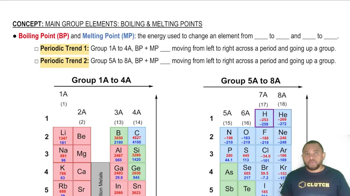Here are the essential concepts you must grasp in order to answer the question correctly.
Gibbs Free Energy
Gibbs Free Energy (G) is a thermodynamic potential that helps predict the direction of chemical reactions and phase changes. It combines enthalpy (ΔH) and entropy (ΔS) into a single value, allowing us to determine if a process is spontaneous at constant temperature and pressure. The relationship is given by the equation ΔG = ΔH - TΔS, where T is the temperature in Kelvin.
Recommended video:
Gibbs Free Energy of Reactions
Phase Change and Melting Point
The melting point of a substance is the temperature at which it transitions from solid to liquid. This process involves a change in enthalpy (ΔHfusion) and entropy (ΔSfusion). At the melting point, the Gibbs Free Energy change (ΔG) is zero, indicating that the solid and liquid phases are in equilibrium.
Recommended video:
Boiling Point and Melting Point
Calculating Melting Point
To find the melting point of magnesium, we can rearrange the Gibbs Free Energy equation to solve for temperature: T = ΔHfusion / ΔSfusion. By substituting the given values of ΔHfusion and ΔSfusion into this equation, we can calculate the melting point in Kelvin and then convert it to Celsius by subtracting 273.15.
Recommended video:
Boiling Point and Melting Point

 Verified step by step guidance
Verified step by step guidance


